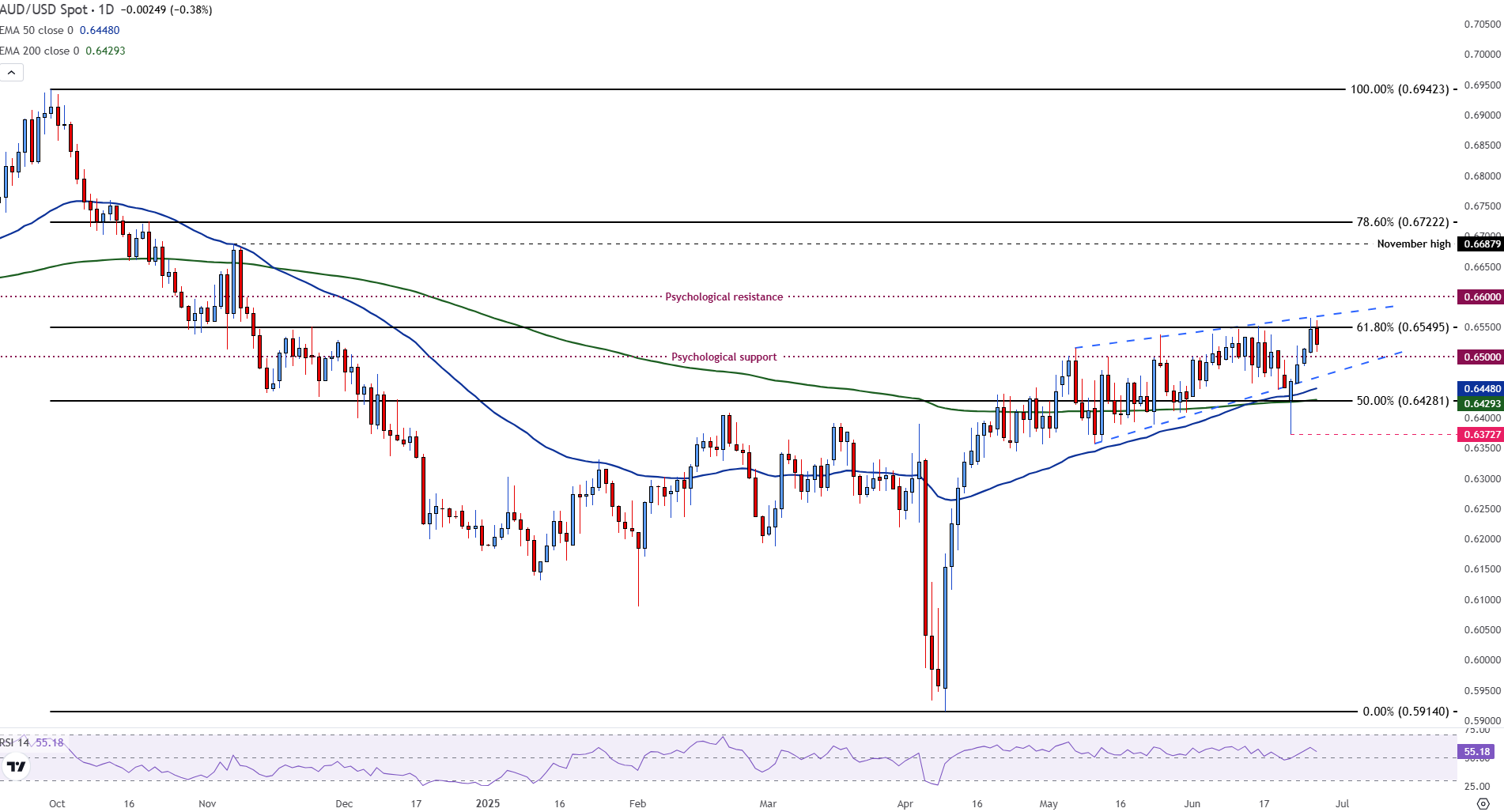Created
: 2025.06.28














![]() 2025.06.28 04:38
2025.06.28 04:38
The Australian Dollar (AUD) is pulling back from weekly highs against the US Dollar (USD) on Friday.
At the time of writing, the AUD/USD pair is trading near 0.6520, having reached an intraday high of 0.6561.
The US Dollar is recovering slightly after falling to three-year lows against its peers. On Friday, the Bureau of Economic Analysis released the latest core Personal Consumption Expenditure (PCE) figures. The core numbers, which reflect the pace at which prices are rising for goods excluding volatile items such as food and energy, increased in May. The annual rate increased by 2.7%, higher than the previously estimated 2.6%, with the monthly figure rising by 0.2 percentage points.
The Federal Reserve's (Fed) preferred measure of inflation is closely monitored for potential clues on the trajectory of monetary policy. However, with President Trump placing pressure on the Fed to reduce rates prior to the September meeting, investors were also looking at the Michigan Sentiment Index numbers, which reflected a slight increase in optimism in June.
Despite the release of macroeconomic data, the easing of geopolitical tensions this week has been a major driver of the surge in the AUD/USD price.
With the ceasefire between Israel and Iran boosting demand for risk assets, safe-haven flows had diminished, placing additional pressure on the Greenback. News of China and the United States finalizing a trade deal on Friday provided additional support for AUD/USD, which was eager to retest the key psychological resistance level of 0.6600.
As markets continued to digest the recent developments and prepared to close, an increase in profit-taking sent AUD/USD lower.
From a technical standpoint, AUD/USD has been trading within a rising wedge pattern, a structure often associated with a potential bearish reversal.
The pair attempted to break above the 61.8% Fibonacci retracement of the September-April downtrend around 0.6550 but failed to sustain momentum.
AUD/USD daily chart

The rejection at this level has triggered a fresh wave of selling, with immediate support now seen at the 50-day Exponential Moving Average (EMA) near 0.6448. Below that is the 200-day EMA at 0.6427, a break of which could expose Monday's low of 0.6372.
Meanwhile, the Relative Strength Index (RSI) is at 55 and is pointing downward, indicating a fading of bullish momentum. The near-term outlook for AUD/USD remains cautious. While improved sentiment earlier this week lifted the pair, the inability to clear key resistance levels and resurgent demand for the US Dollar could signal the potential for additional downside risks.
The US Dollar (USD) is the official currency of the United States of America, and the 'de facto' currency of a significant number of other countries where it is found in circulation alongside local notes. It is the most heavily traded currency in the world, accounting for over 88% of all global foreign exchange turnover, or an average of $6.6 trillion in transactions per day, according to data from 2022. Following the second world war, the USD took over from the British Pound as the world's reserve currency. For most of its history, the US Dollar was backed by Gold, until the Bretton Woods Agreement in 1971 when the Gold Standard went away.
The most important single factor impacting on the value of the US Dollar is monetary policy, which is shaped by the Federal Reserve (Fed). The Fed has two mandates: to achieve price stability (control inflation) and foster full employment. Its primary tool to achieve these two goals is by adjusting interest rates. When prices are rising too quickly and inflation is above the Fed's 2% target, the Fed will raise rates, which helps the USD value. When inflation falls below 2% or the Unemployment Rate is too high, the Fed may lower interest rates, which weighs on the Greenback.
In extreme situations, the Federal Reserve can also print more Dollars and enact quantitative easing (QE). QE is the process by which the Fed substantially increases the flow of credit in a stuck financial system. It is a non-standard policy measure used when credit has dried up because banks will not lend to each other (out of the fear of counterparty default). It is a last resort when simply lowering interest rates is unlikely to achieve the necessary result. It was the Fed's weapon of choice to combat the credit crunch that occurred during the Great Financial Crisis in 2008. It involves the Fed printing more Dollars and using them to buy US government bonds predominantly from financial institutions. QE usually leads to a weaker US Dollar.
Quantitative tightening (QT) is the reverse process whereby the Federal Reserve stops buying bonds from financial institutions and does not reinvest the principal from the bonds it holds maturing in new purchases. It is usually positive for the US Dollar.
![]()
Created
: 2025.06.28
![]()
Last updated
: 2025.06.28

FXStreet is a forex information website, delivering market analysis and news articles 24/7.
It features a number of articles contributed by well-known analysts, in addition to the ones by its editorial team.
Founded in 2000 by Francesc Riverola, a Spanish economist, it has grown to become a world-renowned information website.
We hope you find this article useful. Any comments or suggestions will be greatly appreciated.
We are also looking for writers with extensive experience in forex and crypto to join us.
please contact us at [email protected].
Disclaimer:
All information and content provided on this website is provided for informational purposes only and is not intended to solicit any investment. Although all efforts are made in order to ensure that the information is correct, no guarantee is provided for the accuracy of any content on this website. Any decision made shall be the responsibility of the investor and Myforex does not take any responsibility whatsoever regarding the use of any information provided herein.
The content provided on this website belongs to Myforex and, where stated, the relevant licensors. All rights are reserved by Myforex and the relevant licensors, and no content of this website, whether in full or in part, shall be copied or displayed elsewhere without the explicit written permission of the relevant copyright holder. If you wish to use any part of the content provided on this website, please ensure that you contact Myforex.
Myforex uses cookies to improve the convenience and functionality of this website. This website may include cookies not only by us but also by third parties (advertisers, log analysts, etc.) for the purpose of tracking the activities of users. Cookie policy